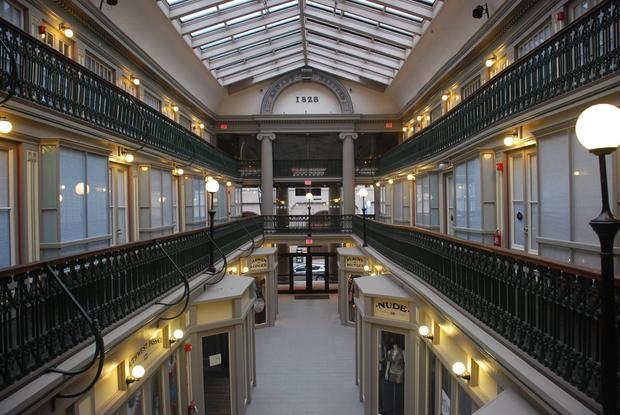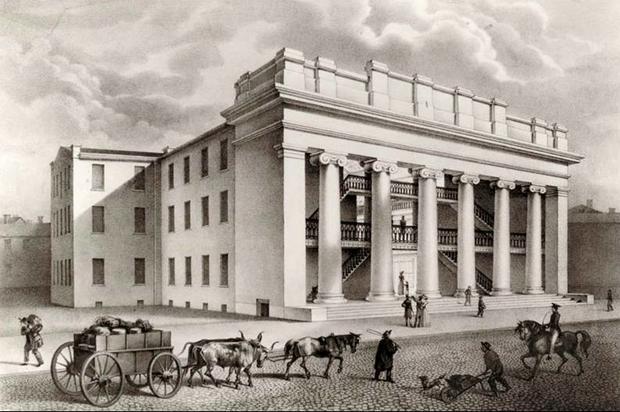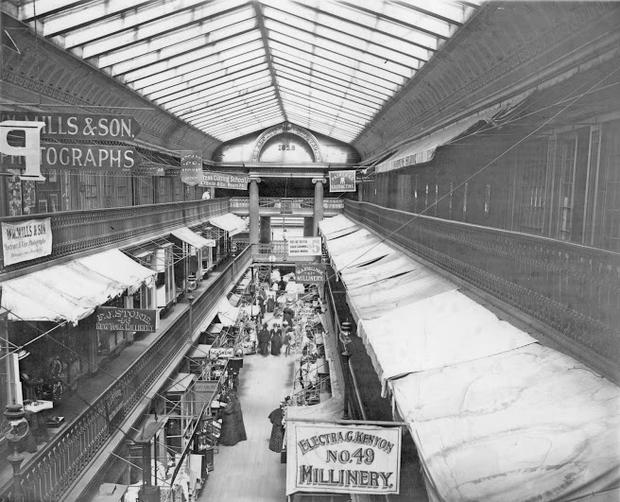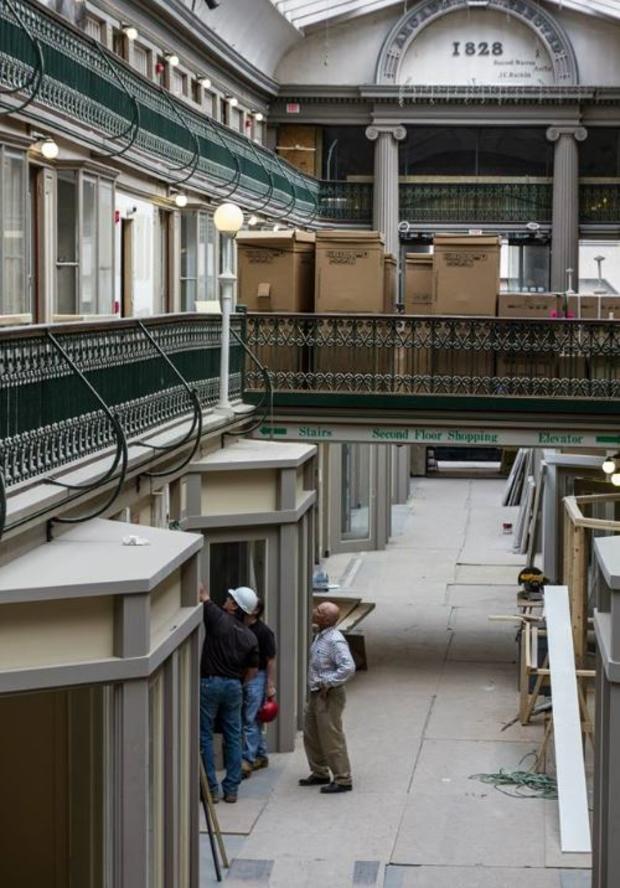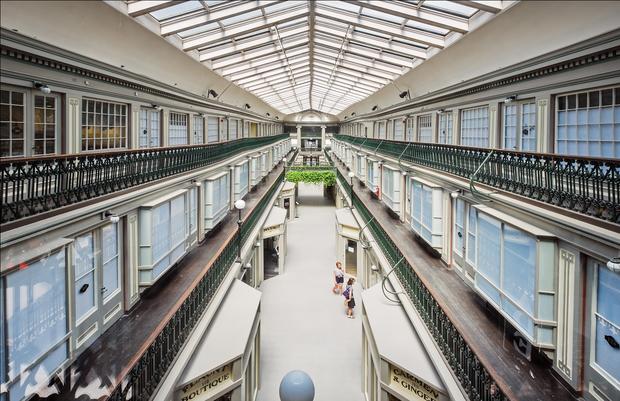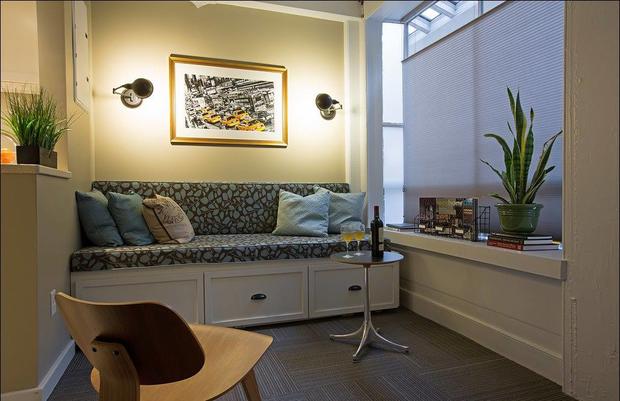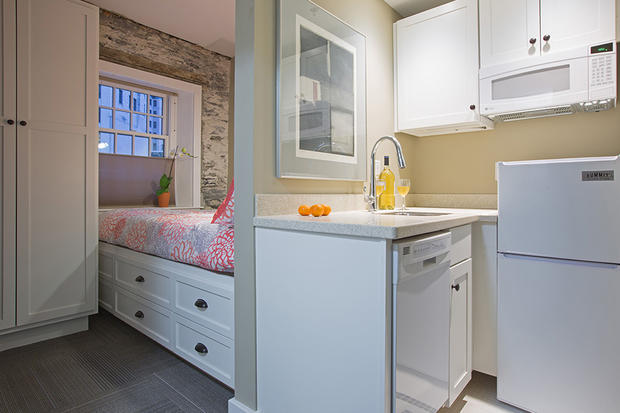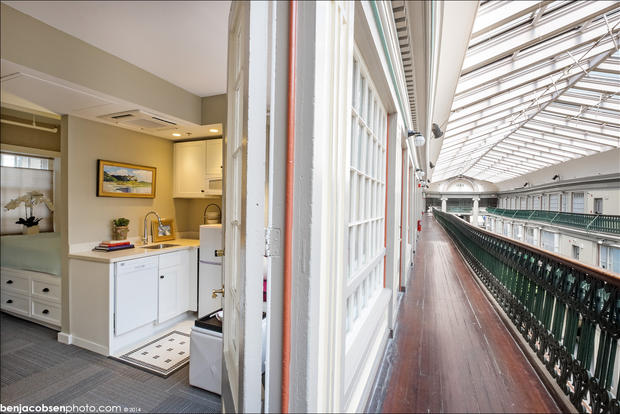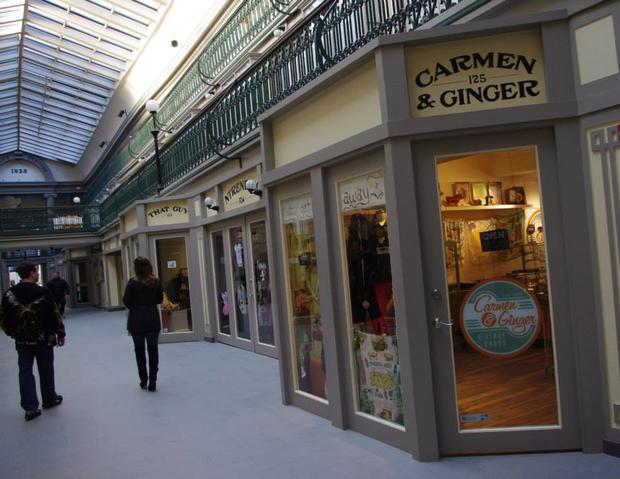Micro-loft living in America's oldest indoor mall
Photo courtesy of the Arcade Providence
Living in the mall is probably a teen dream. But it's also a reality in Providence, Rhode Island, where nearly 100 micro-lofts, many of them 225-square-foot studios, came online in a historic shopping mall last fall.
While the lofts at the Arcade are likely the first of their kind located inside a mall, small-scale living is a wider trend across the U.S., mostly in cities where finding inexpensive ways to provide housing for people is a serious problem. Places like New York, San Francisco, Boston, Seattle and Chicago have reduced the square footage requirements for apartments in recent years, with some going as small as 220 square feet, according to Bloomberg Businessweek.
At the Arcade, considered America's oldest indoor mall, owner-developer Evan Granoff made his vision for a thriving "live small/play big" micro-loft community a reality -- but not before the historic site survived a few bouts of economic hardship.
The Westminster Arcade, a historic landmark
Photo courtesy of the Rhode Island Historical Society
The Westminster Arcade first became a part of downtown Providence, looking over Westminster and Weybosset Streets, in 1828. It features Greek-revival columns, granite walls and a large atrium with skylights. The building was declared a National Historic Landmark in 1976.
"When it was built, it wasn't common to see so many retailers in one space," said Robin Dionne, director of outreach and client relations at the now-renamed Arcade Providence. "Nordstrom and Macy's did not exist. So for small businesses, the downtown area was the place to be. As people spread out to the suburbs, people's shopping habits changed."
More stairs, more problems
Photo courtesy of the Rhode Island Collection
With changing habits came changing expectations for what a shopping mall should offer. One problem for the Arcade was that it had three floors and the only way to reach the top was by climbing a lot of stairs. Since an elevator was added in the 1970s, the Arcade Providence has been more accessible for people with disabilities, according to Dionne. But the second and third floor retailers still weren't doing as much business.
"Walkup second- and third-floor retail in Providence is not economically viable," Granoff said in a 2013 interview with Better Cities and Towns.
Closed, but not forgotten
Photo courtesy of Justin Earsing
During the Great Recession, Providence's downtown financial district, where the Arcade is located, experienced an office space exodus. Vacancies became such a problem that the nearby Bank of America building was eventually emptied, which had a hugely negative impact on the mall's bottom line.
This downturn did what others had only threatened to do: The Arcade Providence was forced to close its doors to the public.
"I think people definitely saw it coming," Dionne said. "By the time we decided to close, there were only seven or eight tenants left. But people really love the building, so I think everyone in general was sad."
Rumors
Photo by Ben Jacobsen, courtesy of Northeast Collaborative Architects
Despite the Arcade's historic landmark status, rumors began to develop about the fate of the mall.
"It had been saved from demolition in years past," Dionne said, "and people were worried it would be destroyed or taken over by one tenant."
These rumors got worse when the Arcade Providence was added to the Providence Preservation Society's 10 Most Endangered Buildings list in 2010. Fortunately for preservationists, Granoff had other ideas for the Arcade, but at first it wasn't clear which one he wanted to pursue.
"When the owner decided to close, he didn't know what his plan was," said Dionne. "He had lots of potential ideas -- it could have become a lobby for the hotel next door."
New beginnings
Photo by Ben Jacobsen, courtesy of Arcade Providence
Finally, Granoff announced his decision: He would work with J. Michael Abbott of Northeast Collaborative Architects to create an affordable micro-living environment targeted at the large population of students and young professionals in Providence.
"He knew there was a huge market of young people trying to establish themselves," Dionne said. "It was his idea for professionals on-the-go, for people who don't want roommates."
The original plan was to open in the fall of 2012 with a budget of $7 million. Of course, due to some unforeseen pitfalls and historic mandates, the new Arcade Providence didn't wrap up construction until fall last year and cost $10 million.
The micro-lofts
Photo by Ben Jacobsen, courtesy of Arcade Providence
Shortly thereafter, the renovated Arcade Providence began renting out its ultra-efficient housing units, and reached capacity within less than a year. There are currently more than 4,000 people on the waiting list.
The building's 48 pet-free micro-lofts have between 225 and 450 square feet of space. There are 46 one-bedroom units, one two-bedroom unit and one three-bedroom unit. All of them feature built-in beds and seating, full baths with showers, tankless hot water units, a half-size refrigerator, sink, dishwasher and microwave -- but no stove or oven. Utilities, access to a storage facility, laundry room, common space and bicycle lock-up area are included in the price of rent, which starts at $550 per month. Garage parking is available to renters for an additional $250 per month.
No stove?
Photo by Ben Jacobsen, courtesy of Northeast Collaborative Architects
While the Arcade's micro-lofts allow tenants to optimize space without foregoing many creature comforts, there is the issue of cooking without a stove or an oven.
"Sometimes the tenants ask me questions about food," Dionne said, acknowledging that it can be an adjustment.
One got a NutriBullet to start making juice and another was cooking in his Crock-Pot, she said.
But the location is good...
Photo by Ben Jacobsen, courtesy of Northeast Collaborative Architects
For renters who aren't interested in drinking juice for dinner, there are a few dining options among the Arcade's first-floor retailers. The Rogue Island Kitchen and Bar provides a menu with food and drinks. There's also New Harvest Coffee and Spirits, a coffee shop and bar headquartered in the nearby Pawtucket area which serves lunch, pastries and drinks.
Shopping
Photo by Ben Jacobsen, courtesy of Arcade Providence
The city of Providence, which had a vested economic interest in the Arcade renovation, agreed to reduce the mall's property taxes for almost a decade. That allowed Granoff and his team to charge less in rent to Providence small businesses, most of which have a strong online presence. The Arcade's retail spaces are also relatively "micro" -- between 641 and 2,300 square feet.
"We tried to keep everything loosely tied to art, style and design," Dionne said. "There's a local jeweler, a vintage clothing boutique, another boutique -- the owner was on 'Project Runway Season 7,' so he has a large following -- and an art gallery with unusual African art that sells to museums."
Why live small?
Photo by Ben Jacobsen, courtesy of Northeast Collaborative Architects
The innovative retail and residential environment at the Arcade has been recognized many times since its launch. Perhaps most significantly, the Museum of the City of New York included the Arcade micro-lofts in its 2013 "Making Room: New Models for Housing New Yorkers" exhibition, along with several other small-scale living models. More locally, Grow Smart Rhode Island recently presented the Arcade project with its 2014 Outstanding Smart Growth award.
"Preservationists, tenants and tourists have been really happy," said Dionne. "The units are not for sale, but people have tried to buy them. ... I wish we had another Arcade so we could do this again -- it's the developer's first residential building."
If you think you might be interested in micro-living, whether at the Arcade or anywhere else, Dionne offers this simple advice: Don't bring a lot of useless stuff.
"People will panic and ask, 'Will this fit?' Before you buy anything, spend a few days in your space and make decisions. Will you use everything you own and is it worth keeping? If not, it might be time to de-clutter."
Dionne also highlighted the way neighbors in the micro-community tend to look out for each other. To hear her explain it, the Arcade's brand of neighborly attention could be really great -- or really unsettling.
"There isn't a hiding spot in the whole building."
